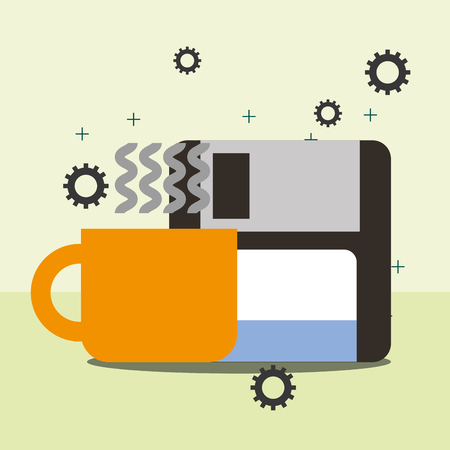1. Understanding the Coffee Shop Vibe
Coffee shops have become go-to spots for remote workers, students, freelancers, and creatives alike. But what makes them so appealing for getting things done? It’s a unique blend of atmosphere, background noise, and that ever-present aroma of fresh coffee that sets the tone for productivity—at least most of the time.
Let’s break it down:
| Why People Love Working in Coffee Shops | How It Can Be Distracting |
|---|---|
| Ambient noise helps some people focus better than silence. | Conversations nearby can pull your attention away from work. |
| The casual setting feels less stressful than an office. | The laid-back vibe might make it easy to procrastinate. |
| Easy access to caffeine keeps energy levels up. | Lines at the counter or frequent trips for refills can interrupt flow. |
| Being around others creates a sense of accountability. | Noisy kids, loud music, or busy crowds may be hard to ignore. |
Coffee shops strike a balance between social buzz and solo focus. For many, this energetic environment provides just enough stimulation to get into a productive zone. However, it’s easy to cross the line where that same buzz becomes overwhelming. Recognizing both sides of the coffee shop vibe is the first step in managing distractions and making these spaces work in your favor.
2. Choosing the Right Seat for Focus
Finding the perfect seat in a busy coffee shop can make all the difference when youre trying to stay focused. Whether youre working on a big project, studying for an exam, or just trying to read in peace, where you sit can either help you concentrate or pull your attention away every few minutes. Heres what to consider when picking your spot.
Key Factors to Consider
The seating options in a coffee shop vary widely, but some spots are better suited for focus than others. Below is a quick comparison of common seating areas and how they might affect your concentration:
| Seat Location | Pros | Cons |
|---|---|---|
| Near an Outlet | Easy access to power for laptops and phones | May be close to high-traffic areas or loud conversations |
| Away from Foot Traffic | Fewer distractions from people walking by | Might be farther from restrooms or outlets |
| Facing a Wall | Minimizes visual distractions; creates a private workspace vibe | Can feel a bit closed off or isolating for long periods |
| Window Seats | Naturally lit and great for inspiration | Outside activity might become a distraction |
Tips for Picking Your Spot
1. Prioritize Power Access if You’re Staying Long
If youre planning to be there for several hours, look for a seat near an outlet so you don’t have to move when your battery runs low.
2. Scout Before Settling In
Take a minute to walk around the space before choosing your seat. Notice where the busiest paths are—near the counter, bathroom, or entrance—and try to avoid those areas if you want fewer interruptions.
3. Use Physical Barriers When Possible
Sitting against a wall or using furniture like bookshelves as dividers can help block out movement and noise behind you.
4. Bring Headphones as Backup
No matter where you sit, having headphones ready can help drown out unexpected noises and keep you in the zone.
Your Ideal Seat Depends on Your Task
If youre doing deep work like writing or coding, face a wall or sit in a quieter corner. If youre brainstorming or meeting someone, window seats or central tables might feel more energizing. The key is to align your seat choice with your purpose so that the environment supports—not hinders—your productivity.

3. Creating a Personal Productivity Zone
Working in a bustling coffee shop can be inspiring, but it’s easy to get sidetracked by background chatter, steaming milk machines, and the constant flow of people. To stay focused, its essential to create your own mental workspace—even in the middle of a lively café. Here are a few tools and habits that can help you stay in the zone:
Noise-Canceling Headphones: Your First Line of Defense
If youre serious about concentrating, noise-canceling headphones are a game-changer. They block out ambient noise and let you control what you hear. Whether it’s lo-fi beats or white noise, having a consistent audio environment helps signal your brain that it’s time to focus.
Recommended Features to Look For:
| Feature | Why It Matters |
|---|---|
| Active Noise Cancellation (ANC) | Reduces external sounds so you can stay focused. |
| Comfortable Fit | Allows for long work sessions without discomfort. |
| Long Battery Life | Keeps you powered through extended coffee shop visits. |
Curated Playlists: Set the Mood for Focus
The right playlist can make all the difference. Choose music that keeps your energy up but doesn’t distract you. Many people find instrumental or ambient tracks work best—no lyrics means fewer distractions.
Popular Playlist Options:
- Lo-fi Hip Hop Beats: Great for a chill, steady rhythm.
- Classical Essentials: Perfect for deep concentration.
- Coffee Shop Jazz: Keeps the vibe cozy without being too busy.
Create Personal Rituals That Signal “Focus Time”
Your brain loves routines. Simple actions like opening your laptop, taking a sip of coffee, and pressing play on your favorite playlist can become signals that its time to get into work mode. These small rituals help train your mind to shift gears quickly, even in a noisy space.
Sample Productivity Ritual:
- Order your go-to drink (consistency helps build routine).
- Find a familiar table or seating area if possible.
- Put on your headphones and start your playlist.
- Review your to-do list or open your productivity app.
- Dive into your first task with intention.
The goal is to create a micro-environment where everything—from sound to behavior—tells your brain it’s time to get things done. With the right gear and habits, even the busiest café can become your personal productivity zone.
4. Managing Digital and Social Interruptions
When youre working in a buzzing coffee shop, your devices and friendly faces can easily pull you away from what youre trying to get done. Whether its notifications lighting up your screen or a buddy dropping by to say hi, these little interruptions can add up fast. Here are some practical tips to help you stay focused without being rude or completely cutting yourself off.
Tips for Minimizing Device Distractions
Your phone and laptop can be productivity tools—but also major distractions. Use these strategies to keep them in check:
| Tip | Why It Helps |
|---|---|
| Use Do Not Disturb Mode | Silences notifications so you’re not constantly pulled away by messages or app alerts. |
| Turn Off Non-Essential Apps | Reduces temptation from social media, games, or unnecessary browsing. |
| Set Specific Times to Check Your Phone | Helps create boundaries and keeps you focused during work blocks. |
| Use Website Blockers or Focus Apps | Apps like Freedom or Cold Turkey help limit access to distracting sites. |
Handling Friendly Interruptions Gracefully
Coffee shops are social spaces—it’s part of their charm. But if you bump into someone you know or make new friends, it can derail your workflow. Heres how to manage it politely:
- Create Visual Cues: Wearing headphones is a universal “I’m busy” signal. Even if music isn’t playing, it helps set boundaries.
- Keep It Brief: If someone starts chatting, smile and let them know you’re on a deadline but would love to catch up later.
- Pick the Right Spot: Choose a seat that’s slightly tucked away or facing a wall to minimize chances of casual interactions.
- Schedule Social Breaks: If you enjoy socializing at the café, plan short breaks where you can chat guilt-free without interrupting your workflow.
Example Phrase You Can Use:
“Hey! Great to see you. Im actually working on a tight deadline right now, but lets definitely catch up later!”
A Balanced Approach
You don’t need to isolate yourself completely to stay productive in a coffee shop. With a few smart habits and a polite approach, you can enjoy the vibe of the café while still getting your work done efficiently.
5. Setting Time Boundaries and Break Strategies
When youre working or studying in a lively coffee shop, its easy to lose track of time. The ambient noise, people chatting, and the constant movement can make it hard to stay focused for long periods. Thats why setting clear time boundaries and having a smart break strategy are key to staying productive without burning out.
Time-Blocking: Structure Your Day
Time-blocking is a simple but powerful way to manage your day. It means dividing your work into chunks of time where you focus on one specific task only. For example, you might block off 25 minutes to write an email, then take a 5-minute break before moving on to the next task. This helps you stay on track and avoid multitasking, which can be especially tempting in a busy café.
Sample Time-Blocking Schedule
| Time | Activity |
|---|---|
| 9:00 AM – 9:25 AM | Check emails |
| 9:25 AM – 9:30 AM | Short break (stretch or walk) |
| 9:30 AM – 10:00 AM | Work on main project |
| 10:00 AM – 10:05 AM | Refill coffee / quick break |
This kind of schedule keeps you focused while still giving your mind space to recharge.
Use Timers to Stay Accountable
A timer can be your best friend when trying to stay productive in a busy environment. Whether its your phone, a laptop app, or even a small kitchen timer, setting it for each work session helps create a sense of urgency and keeps distractions at bay. Try using the Pomodoro Technique—25 minutes of focused work followed by a 5-minute break—for an easy and effective rhythm.
Plan Intentional Breaks
Breaks aren’t just about stepping away—they’re about resetting your brain so you can come back sharper. Instead of scrolling on your phone, try doing something that actually recharges you:
- Take a short walk outside or around the café.
- Listen to calming music with headphones.
- Do a quick breathing exercise or stretch.
The key is to plan these breaks ahead of time so they don’t turn into long distractions.
Keep It Flexible
Your time plan doesn’t have to be rigid. Life happens—especially in unpredictable environments like coffee shops. What matters most is having a structure that supports your focus while allowing flexibility when needed. By combining time-blocking, timers, and thoughtful breaks, you’ll find it much easier to stay productive even with all the buzz around you.
6. Knowing When It’s Time to Relocate
Even the coziest coffee shop can go from your favorite workspace to a major distraction zone. While it’s great to enjoy the buzz of a lively environment, there comes a point when the noise, crowd, or even the music playlist starts to hurt your focus more than help it. Recognizing when its time to pack up and find a new spot is key to staying productive.
Signs It Might Be Time to Move On
Here are some common signs that your current coffee shop setup might not be working for you anymore:
| Sign | What It Looks Like |
|---|---|
| You’re constantly distracted | You find yourself people-watching or eavesdropping more than working. |
| The noise level has increased | A group just sat next to you having a loud meeting or kids are playing nearby. |
| Your internet connection is unstable | Pages take forever to load or your video call keeps freezing. |
| Your seat is uncomfortable | The chair hurts your back or there’s no outlet nearby for charging. |
| You’ve been there too long | You feel guilty occupying space without ordering more or it’s getting close to closing time. |
How to Make a Smooth Exit
If you realize its time to relocate, do it respectfully. Clear your table, toss any trash, and maybe leave a small tip—especially if you stayed for hours on one cup of coffee. Then, consider your next move: is there another café nearby? Would a library or co-working space serve you better right now?
Pro Tip:
Keep a list of backup work spots in your phone so you’re never stuck scrambling when one place doesn’t work out. Think of it like having different playlists for different moods—you want the right vibe for the right task.

